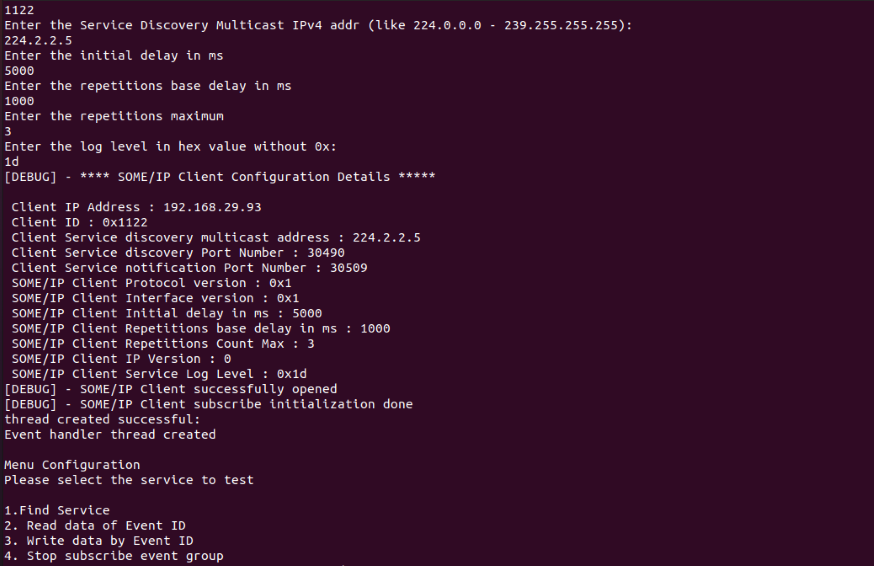SOME/IP Client Demo
There is an example implementation of SOME/IP client demo available in apps folder.Initially SOME/IP server started the UDP socket connection. Once client connected to the server SOME/IP client broadcast the Find service request. Once client connected, send the request to the server.Server send the response to the client.
In this implementation, a simple command line interface (CLI) is used to trigger various services on to the ECU/server like eventgroup subscribe, read and write data using SOME/IP request response method.
The below diagram captures the high level flow of client and server of SOME/IP.
Service Discovery Process
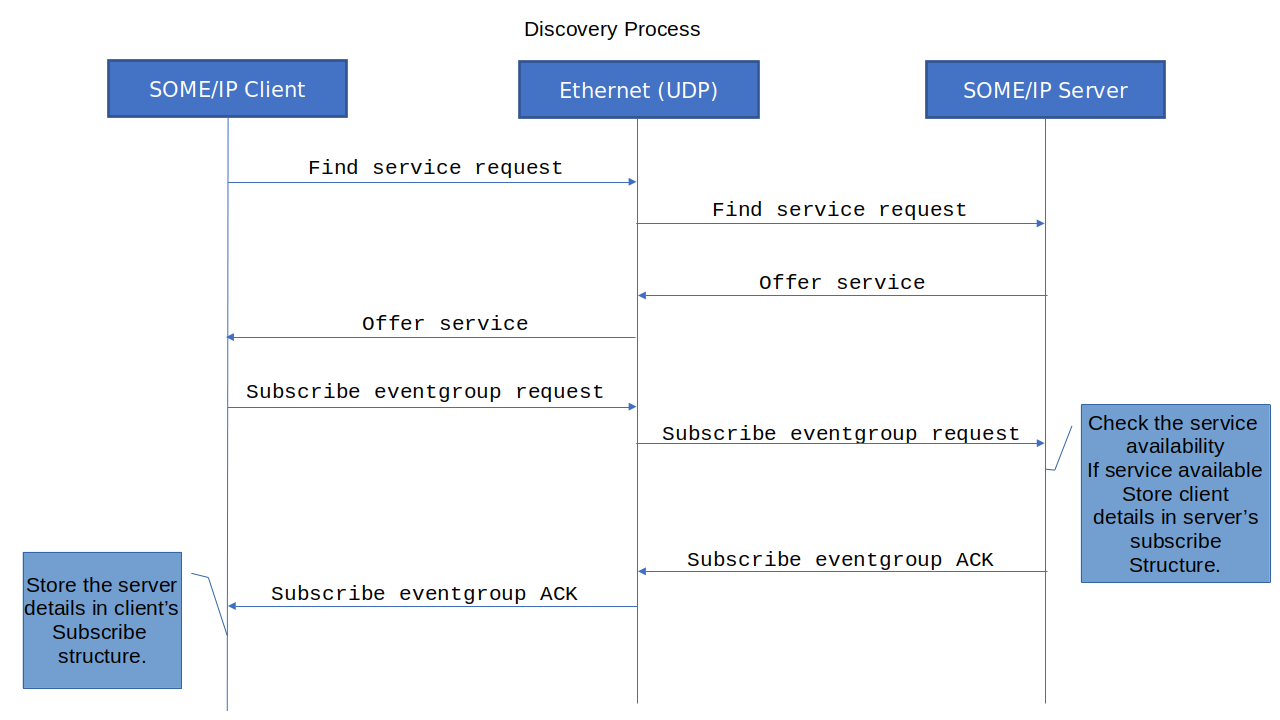
Notification Process
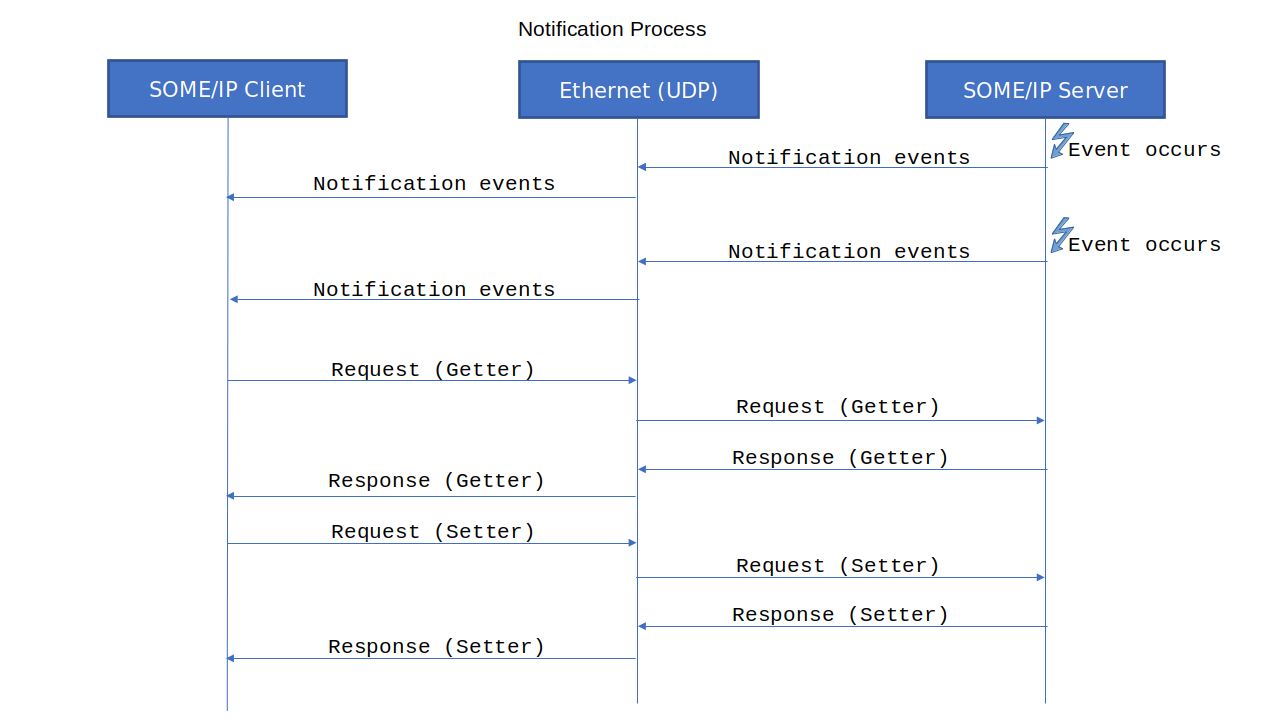
Client Service Details Information
Service ID |
Instance ID |
TTL |
Major Ver |
Minor Ver |
|---|---|---|---|---|
0x1234 |
0x5678 |
15 |
1 |
0 |
0x1234 |
0x5678 |
26 |
2 |
5 |
0x1235 |
0x5679 |
17 |
1 |
0 |
0x1234 |
0x5678 |
10 |
4 |
4 |
0x1235 |
0x5678 |
30 |
1 |
0 |
Client Eventgroup Details Information
Service ID |
Instance ID |
Eventgroup |
Multicast Port |
|---|---|---|---|
0x1234 |
0x5678 |
0x4425 |
35689 |
0x1234 |
0x5678 |
0x4426 |
0 |
0x1234 |
0x5678 |
0x4425 |
35689 |
0x1234 |
0x5678 |
0x4426 |
35689 |
0x1235 |
0x5679 |
0x4425 |
0 |
0x1235 |
0x5678 |
0x4425 |
0 |
0x1235 |
0x5678 |
0x4425 |
0 |
Client Event Information
Service ID |
Instance ID |
Major Version |
Eventgroup ID |
Event ID |
|---|---|---|---|---|
0x1234 |
0x5678 |
1 |
0x4425 |
0x8001 |
0x1234 |
0x5678 |
1 |
0x4425 |
0x8002 |
0x1234 |
0x5678 |
1 |
0x4425 |
0x8003 |
0x1234 |
0x5678 |
1 |
0x4426 |
0x8004 |
0x1234 |
0x5678 |
1 |
0x4426 |
0x8005 |
0x1234 |
0x5678 |
1 |
0x4426 |
0x8006 |
0x1234 |
0x5678 |
2 |
0x4425 |
0x8007 |
0x1234 |
0x5678 |
2 |
0x4425 |
0x8008 |
0x1234 |
0x5678 |
2 |
0x4426 |
0x8009 |
0x1235 |
0x5679 |
1 |
0x4425 |
0x800A |
0x1235 |
0x5679 |
1 |
0x4425 |
0x800B |
0x1234 |
0x5678 |
4 |
0x4425 |
0x800C |
0x1235 |
0x5678 |
1 |
0x4425 |
0x800D |
0x1235 |
0x5678 |
1 |
0x4425 |
0x800E |
Client Event Data Information
Event ID |
User Data Type |
Description |
|---|---|---|
0x8001 |
uint8 |
Wheel Slip Status |
0x8002 |
uint16 |
Speed Data |
0x8003 |
uint32 |
RPM Data |
0x8004 |
int8 |
Engine State |
0x8005 |
int16 |
Steering Data |
0x8006 |
int32 |
Yaw State |
0x8007 |
One-D Array |
Peak Vol Current |
0x8008 |
One Dimensional Array |
State of charge |
0x8009 |
Multi Dimensional Array |
Battery Heat Grid |
0x800A |
One Dimensional Array |
ota state message |
0x800B |
One Dimensional Array |
ota error message |
0x800C |
Structure (float …, float .., uint32_t .., uint32_t …) |
Vehicle Pos Event data (latitude, longitude, speed, heading_direction) |
0x800D |
union (uint8_t, uint16_t, uint32_t) |
Diag Payload Data 1 (status_flags, error_type, fault_code) |
0x800E |
union (uint8_t, uint16_t, uint32_t) |
Diag Payload Data 2 (status_flags, error_type, fault_code) |
Read data by Method ID services:
Event ID |
Method ID in hex |
|---|---|
0x8001 |
11 |
0x8002 |
12 |
0x8003 |
13 |
0x8004 |
14 |
0x8005 |
15 |
0x8006 |
16 |
0x8007 |
17 |
0x8008 |
18 |
0x8009 |
19 |
0x800A |
1A |
0x800B |
1B |
0x800C |
1C |
0x800D |
1D |
0x800E |
1E |
Write data by Method ID services:
Event ID |
Method ID in hex |
|---|---|
0x8001 |
01 |
0x8002 |
02 |
0x8003 |
03 |
0x8004 |
04 |
0x8005 |
05 |
0x8006 |
06 |
0x8007 |
07 |
0x8008 |
08 |
0x8009 |
09 |
0x800A |
0A |
0x800B |
0B |
0x800C |
0C |
0x800D |
0D |
0x800E |
0E |
SOME/IP Client Running Example
Refer to the Supported Platforms page to setup your environmental setup and follow further.
User Configuration for Client (IPV4)
Socket configuration |
Value |
|---|---|
Clients IP address |
IP address of client running PC or machine |
SOMEIP SD PORT |
30490 |
SOMEIP NOTIFY PORT NUM |
30509 |
SOMEIP Client ID in Hex value without hex |
1234 |
SOME/IP client Discovery Multicast Addr(224.0.0.0 - 239.255.255.255) |
224.0.0.0 |
SOME/IP client initial delay (ms) |
500 |
SOME/IP client repetition base delay (ms) |
200 |
SOME/IP client repetitions maximum |
5 |
SOME/IP client log level in hex without(0x) |
1 |

User Configuration for Client (IPV6)
Socket configuration |
Value |
|---|---|
Clients IP address |
IP address of client running PC or machine |
SOMEIP SD PORT |
30490 |
SOMEIP NOTIFY PORT NUM |
30509 |
SOMEIP Client ID in Hex value without hex |
1234 |
SOME/IP Service Discovery Multicast Addr( FF00:0000:0000:0000:0000:0000:0000:0000 to FFFF:FFFF:FFFF:FFFF:FFFF:FFFF:FFFF:FFFF) |
FF05:0000:0000:0000:0000:0000:0000:0000 |
SOME/IP client initial delay (ms) |
500 |
SOME/IP client repetition base delay (ms) |
200 |
SOME/IP client repetitions maximum |
5 |
SOME/IP client log level in hex without(0x) |
1 |
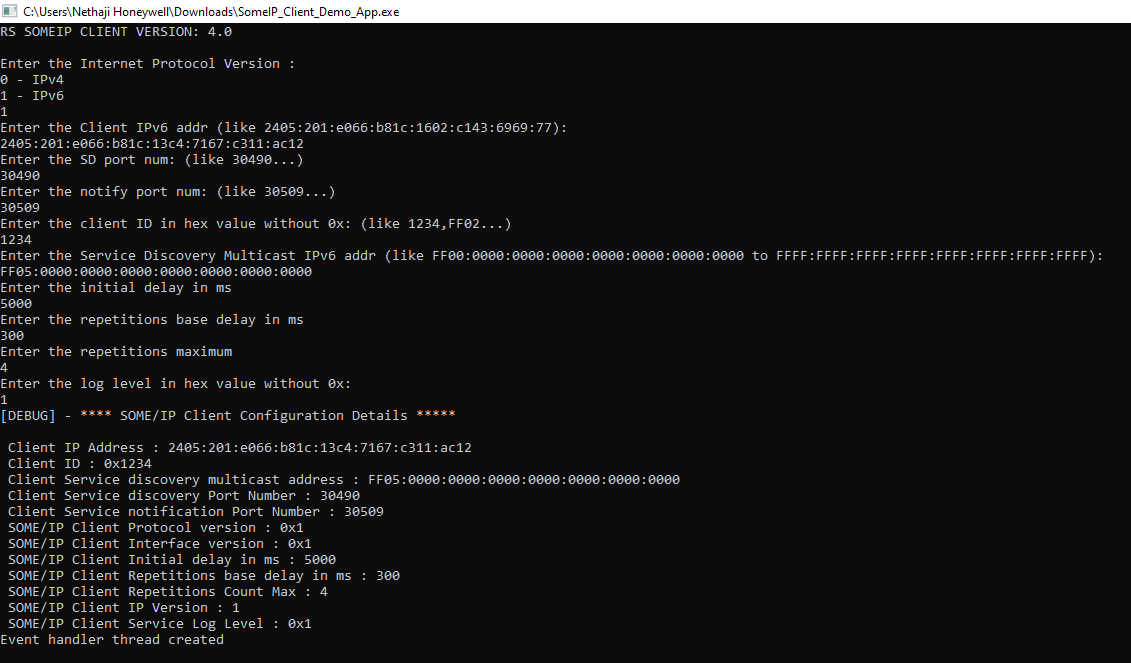
Once run the execution command the (./someip_client_demo) SOME/IP client connecting to SOME/IP server via UDP.
Note : Before run the client we need to run the SOME/IP server on another terminal
Note : The below execution steps are same for both windows and linux.
After initial communication has been done, Its shows the SOME/IP services menu look like below
Find service & Eventgroup subscription
In SOME/IP, first we need to find the service to subscribe to the eventgroup for accessing the event ID for request and response, notification events.
Based on the client service details provided, find the service to get framed and send it to the configured service discovery multicast address with an initial delay in milliseconds.
In between the server sending any offer, the client receives the offer service and frames the subscribe event group message with corresponding service details and sends the subscribe event group service request to the server.
Read data by Method ID
To get the value of a particular method ID on the server side, we need to choose to read data by method ID.
Type 2 and press enter.
Then it will ask, “Please enter the service ID to read in hex.”
Type 1234 and press enter.
After entering the service ID, it will ask for the instance ID: “Please enter the instance ID to read in hex.”
Type 5678 and press enter.
Now enter the method ID; it will ask for the method ID, “Please enter the method ID to read in hex.”
Type 11 and press enter.
Then the server will respond with the reading value for the given method ID. (wheel slip value displayed)
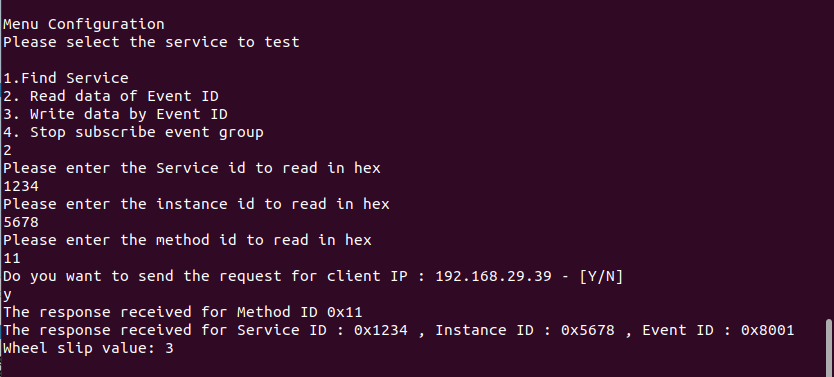
Write data by Method ID
To write the value of a particular method ID on the server side, we need to choose to write data by method ID.
Type 3 and press enter.
Then it will ask, “Please enter the service ID to read in hex.”
Type 1234 and press enter.
After entering the service ID, it will ask for the event ID: “Please enter the instance ID to read in hex.”
Type 5678 and press enter.
Now enter the method ID; it will ask for the event ID: “Please enter the method ID to read in hex.”
Type 1 and press enter.
Now enter the event ID in hex to read. (e.g., 8001)
Then it will ask to select the request type. ‘1’ for request with return response, ‘2’ for fire-and-forget mode.
Type 1 and press enter.
Then it asks to enter a value to write “Enter the Wheel Slip value to write,” i.e., corresponding data of event ID 0x8001.
Now enter the value to write on the respective event ID on the server side. (e.g., 0 or 1 or 3)
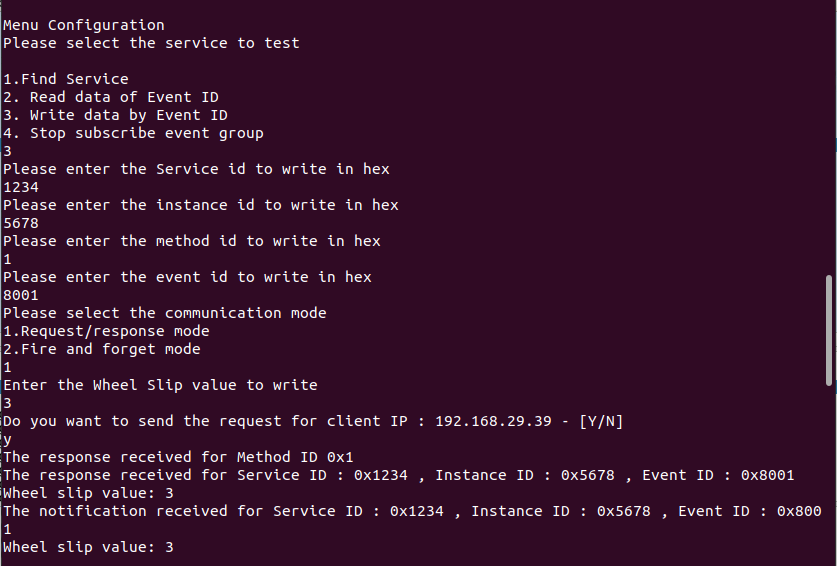
Stop subscribe eventgroup
To stop subscribe eventgroup, we need to choose stop subscribe eventgroup menu
Type 4 and press enter
Based on the client service details we have provided, stop subscription get framed and send to the configured service discovery multicast address with initial delay in milliseconds.
Refer to the SOME/IP protocol page for more details SOME/IP Protocol
